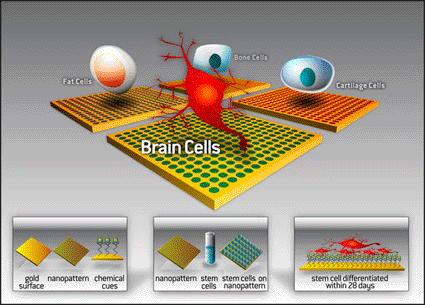Stem Cell Differentiation Maintained Using Nanolithography Technique
By LabMedica International staff writers
Posted on 20 May 2009
New research has shown that a new biotechnology, called dip pen nanolithography (DPN), has created nanopattern chips that provide unparalleled control of stem cell differentiation, including keeping adult stem cells in an undifferentiated form as well as inducing differentiation to a homogenous population of a targeted primary cell type, depending on the chemistry and topography of the pattern. Posted on 20 May 2009
NanoStem Cell (Skokie, IL, USA), a division of NanoInk, Inc., announced that Prof. John Hunt of the UK Center for Tissue Engineering (UKCTE) at the University of Liverpool (UK), presented the results of an ongoing, collaborative research project leveraging NanoInk's proprietary DPN technology to create homogenous nanopattern biochips and control cell functionality in a predictable and reproducible manner. Prof. Duncan Graham of the Center of Molecular NanoMetrology at the University of Strathclyde (Glasgow, Scotland, UK) is also collaborating on the project. Prof. Hunt presented the study's findings at the NanoScience Technology Institute Nanotech Conference & Expo 2009, held in Houston, TX, USA, May 3-7, 2009.

Image: Diagram showing how NanoStem biochips are developed by depositing chemical cues in a precise pattern onto a solid surface using DPN technology (Photo courtesy of NanoInk).
"Through our collaborative efforts and use of our DPN nanopatterning technology, we will be able to provide pharmaceutical and biotech companies with access to large and renewable sources of homogeneous populations of differentiated stem cells for drug discovery, drug development, and high throughput screening,” said Haris Jamil, vice president of NanoInk's NanoStem cell division.
"We are very excited about the results we are generating in this project,” said Prof. John Hunt, UKCTE. "The data show that NanoInk's proprietary Dip Pen Nanolithography technology can be used to present environments suitable for the guidance and control of stem cells for development into functional, phenotypically defined populations of cells.”
"The project and subsequent data generated up to now are impressive. There is great potential in this project and it is definitely worth talking about,” said Prof. Duncan Graham, Center of Molecular NanoMetrology at the University of Strathclyde. "Each component of this collaboration is essential in moving the project forward and generating tangible results in drug discovery, drug development, and regenerative medicine.
The project's findings follow an announcement in March 2009 detailing the joint research and licensing agreements between NanoInk, the UKCTE at the University of Liverpool, and the Center of Molecular NanoMetrology at the University of Strathclyde.
"The results we are generating in this exciting effort will generate substantial cost-savings,” said James M. Hussey, chief executive officer of NanoInk. "But more importantly, the research moves us a step closer toward providing options for patients that may require a regenerative approach to treatment.”
NanoInk is an emerging growth technology company specializing in nanometer-scale manufacturing. Using DPN, a proprietary nanofabrication technology, scientists are able to create nanoscale structures from a wide variety of materials. This scalable technique, in effect, brings nanofabrication to the laboratory desktop.
Related Links:
NanoStem Cell
UK Centre for Tissue Engineering
University of Strathclyde













